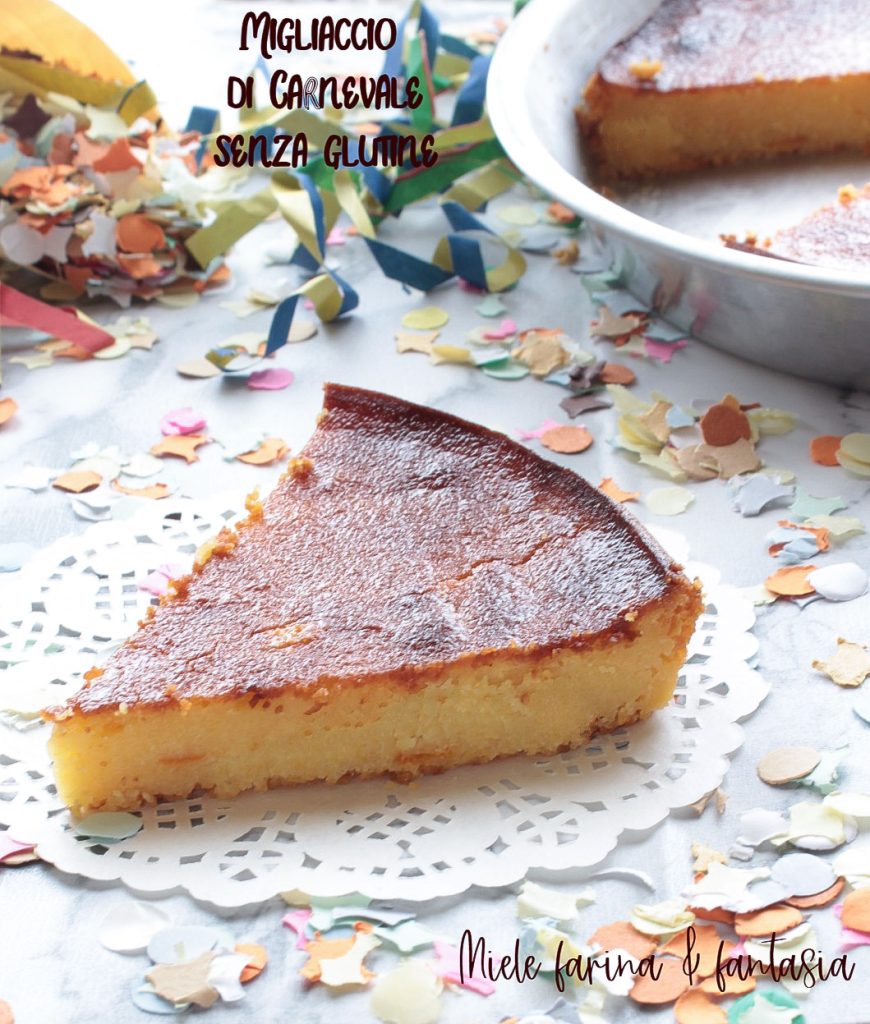Today we talk about a typical sweet from the Campania region during the carnival period, the migliaccio, made in a gluten-free and lactose-free version, equally easy and equally delicious and fragrant. The traditional migliaccio is a preparation based on semolina (coarse-grained durum wheat semolina, also used for Roman gnocchi, not to be confused with fine and almost impalpable durum wheat semolina flour), ricotta and spices that make it compact, moist, and very aromatic. The gluten-free and lactose-free migliaccio, prepared with very fine corn flour type fioretto, has nothing to envy to the classic version, neither in terms of texture nor the aromas released during and after cooking. It’s a delicacy that gives those with specific dietary needs the chance to enjoy this treat, and I assure you that even those who are not celiac or gluten-sensitive will appreciate this rich gluten-free cake.

- Difficulty: Very easy
- Cost: Cheap
- Preparation time: 1 Hour
- Portions: 12
- Cooking methods: Stove, Oven
- Cuisine: Italian
- Seasonality: Carnival
Ingredients
- 4.4 oz very fine corn flour
- 1 cup water
- 1 cup lactose-free milk
- 8.1 oz granulated sugar
- 0.7 oz lactose-free butter
- 0.14 oz fine salt
- 1 orange
- 1 lemon
- 4.4 oz lactose-free cow ricotta
- 2 medium whole eggs (about 3.5 oz)
- 1/4 teaspoon ground cinnamon
- 1/4 teaspoon vanilla paste (or 2 sachets of vanillin)
- 1/4 teaspoon orange blossom water
- as needed butter for the pan
Tools
- 1 Mold
Steps
The mold I usually use for preparing migliaccio is the round aluminum one, with slightly flared edges, 8.66 inches in diameter and 1.57 inches in height (also suitable for the Neapolitan pastiera), perfect for these amounts and to give the migliaccio the typical height of one to one and a half fingers.
Wash and scrub an orange and a lemon. Grate very finely all the zest of both and put it in a thick-bottomed saucepan.
Pour the sugar, milk, water, butter, and salt into the saucepan and place it on the smallest stove over medium flame.
Stir until the butter has melted, and make sure the mixture of liquids does not come to a boil; it should only become warm enough to allow the butter and sugar to melt.
As soon as they have melted, pour in the fioretto polenta flour (the very fine type) and continue to stir with a steel whisk for 15 minutes until all the liquid has been completely absorbed. The result should be a very soft mixture.
After 15 minutes, lower the flame to the minimum and continue stirring to prevent the polenta from starting to pop; continue for another 3-5 minutes at most, then turn off the heat and immediately remove the saucepan from the stove.
Let the obtained mixture cool for 15 minutes, stirring often and without covering it, to avoid condensation.
In the meantime, sift the ricotta by passing it through a medium-sized sieve; if the ricotta appears very dry, you can add up to 6 oz.
Generously butter a mold of 8.66 inches in diameter.
After 15 minutes, add the sifted ricotta, and mix to perfectly blend it into the mixture; then add one egg at a time and stir to incorporate them thoroughly. The eggs I used weighed 3.8 oz in total. Do not exceed this quantity to avoid making the mixture too mushy or liquid.
A tip: if you have added more ricotta than I planned or the eggs are very large and the mixture already seems very, very soft, divide the second egg into yolk and white, adding the yolk first. If it seems that the mixture is still thick enough, then add the white as well; otherwise, desist.
Now we can add all the spices, stir again, and pour the migliaccio (which will have the consistency of a creamy, soft, and dense cake batter) into the buttered mold and into the oven at 392°F for about 60 minutes, mid-level.
It is not important whether the oven is already hot or not at the time of cooking, as the migliaccio does not need to rise.
Since ovens vary, check the cooking, as it may take a little less or more than indicated. In my case, the migliaccio was cooked in a static gas oven with heat only from below.
The gluten-free and lactose-free carnival migliaccio is ready when it becomes a uniform caramel color, as shown in the photo.
Remove it immediately from the oven and let it cool completely before gently removing it from the mold with the help of a spatula. The migliaccio, both the gluten-free and lactose-free version and the classic one, are sweet preparations that need at least 12 hours to best express flavors and aromas, so I recommend preparing it a day in advance. It keeps for 4/5 days in a cake keeper in a cool place or in the fridge if the room temperature is high.
Bon appetit

